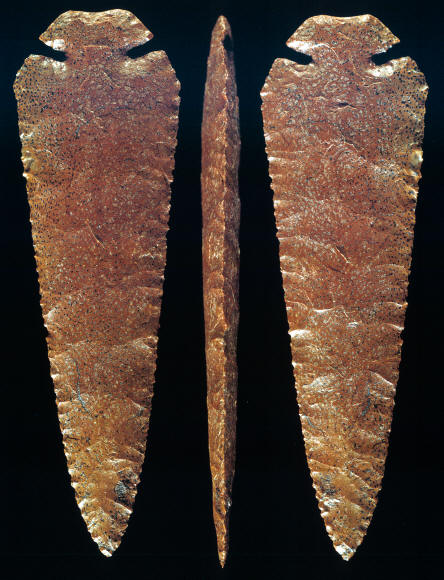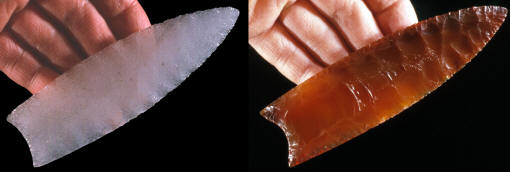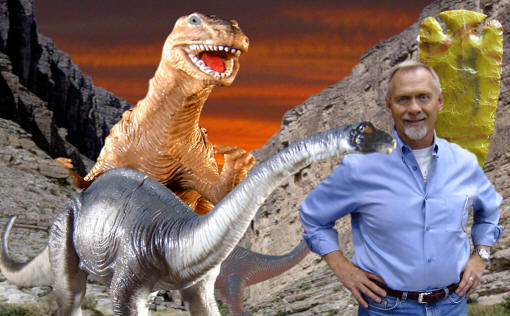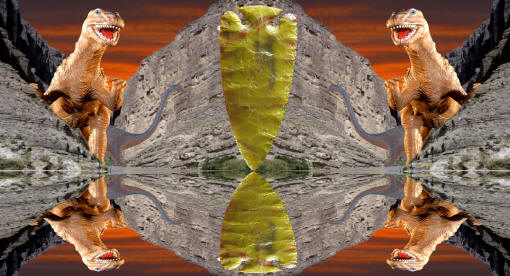|
"The ability to
make a point out of "any" piece of stone is an expression of mastery of
the craft."---2004,
John Whittaker, "American Flintknappers," p. 209.
"Exotic colorful materials have an especially strong allure,
and the expense and rarity of some stones add to the "manna" of a point
made from them. Knappers admire such points for the beauty of the stone
and to some extent, for the daring that went into risking a piece of
expensive material."---2004,
John Whittaker, "American Flintknappers," p. 211.
"Attractive material to a knapper usually means
stone that flakes well with smooth fracture surfaces. Even more
important, it should be colorful."---2004,
John Whittaker, "American Flintknappers," p. 186.

FOSSIL DINOSAUR POINTS
MADE BY DAN THEUS
MODERN
Dan Theus is known for his choice of exotic stones that he uses to make
a wide variety of different types of lithic art points. The theme of
this article is to show two points he made from agatized
dinosaur fossils. Dan is always keeping an eye out for good quality,
colorful and often times rare and expensive specimens of knapable
stone. The yellow point in this article is made from a piece of agatized
fossil dinosaur coprolite (poop). The fossil coprolite had been cut in
two pieces showing that the center contained an area of good quality agate. He cut
away the surrounding crust and made this beautiful point from what was
left. The other point is made of an agatized piece of red colored
dinosaur bone.
|
|

CLICK ON PICTURE FOR LARGER IMAGE
DINOSAUR "POOP" POINT
MADE BY DAN THEUS
MODERN
This skillfully crafted corner notched point was made by Dan Theus.
It was made from an especially colorful piece of fossilized dinosaur
coprolite. The fossil had been cut in two pieces which showed the center had
become agatized. The surrounding crust was cut away to extract the
usable (knapable) stone. This point measures 3 9/16 inches (9.1 cm)
long.
Coprolites were first described by William Buckland in 1828
as the fossil remains of dinosaur feces. They are classified as
trace fossils as opposed to body fossils because they give evidence
for the animal's behavior rather than morphology. Coprolites are
composed mainly of calcium phosphate and minor quantities of organic
matter. They were transformed by replacing their original
composition with mineral deposits such as silicates and calcium
carbonates. Paleontologists consider this type of fossil important
because they provide evidence of animal predation and the diets of
extinct species. Inclusions in the stone can indicate the meal
contents of the dinosaur. Coprolites range in size from under an inch up to almost
2 feet (60 cm) across. |
|
|
It's kind of
amazing
that the two dinosaur fossil points illustrated in this article
originated from simple organic materials. Both materials became agatized
through a process of mineralization. Coprolites were transformed by
replacing their original composition with mineral deposits such as
silicates and calcium carbonates. Dinosaur bone becomes agatized
when the cellular structure is replaced with silica and quartz,
leaving the bone structure intact giving it a glassy appearance. |
|

CLICK ON PICTURE FOR LARGER IMAGE
DINOSAUR BONE POINT
MADE BY DAN THEUS
MODERN
This Dovetail "art" point was made by Dan Theus from a
piece of agatized dinosaur bone. It represents one of the rare
lithic materials Dan has used over the years to make his lithic art
points. This point measures 3 1/4 inches (8.3 cm) long.
Most dinosaur bones were fossilized with calcium which
produces a stony appearance and texture that is not useful for
knapping. Agatized bone, like the material pictured above, is
formed when the cellular structure is replaced with silica and
quartz, leaving the bone structure intact giving it a glassy
appearance. Fossil dinosaur bones have been found in a wide range of
colors that were caused by various types of minerals in the
surrounding sediment. Red and dark yellow-gold are two of the more
rare colors. Other colors are brown, blue, bright yellow and black
with splotches of red. In the United States the largest deposits of
agatized dinosaur bone are concentrated in Colorado and Utah. |
|
|
Flintknappers try to find good stone to knap where ever they can find
it. Common cherts and obsidian are the favorite materials. Beyond that
one can only upgrade into more rare and costly materials until all that
is left are semiprecious stones which of course can be very colorful. John Whittaker writes that, "The ability to
make a point out of "any" piece of stone is an expression of mastery of
the craft." and also, "Exotic colorful materials have an especially
strong allure, and the expense and rarity of some stones add to the
"manna" of a point made from them. |
|

EXOTIC MATERIAL CLOVIS
POINTS
MADE BY DAN THEUS
These two Clovis points
were made by Dan Theus. The exotic materials are unique and
represent what some collectors of modern lithic art are looking for.
The point on the left is made of fulgurite, which is a material that
is formed by lightening striking sand. The point on the right
is made of
a very colorful piece of red Carnelian agate. |
|
|
Dan Theus has
mastered the ability to make a very wide range of point, knife and
eccentric types. His skill level is among a fairly small group of
knappers who have a unique understanding of how stone fractures in many
different ways. He is continually experimenting with new artifact types
and using more and more exotic materials---even dinosaur "poop." |
|
"REFERENCES"
2004,
Whittaker, John, "American Flintknappers," p. 209, 211 & 186.
Personal Communications with Dan Theus
|
|
RECENT
LISTINGS HOME
ORDERING |





